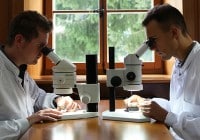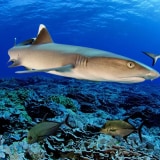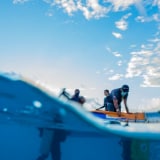
Search in Issues
Chapters
List of parts
Chapter 7
THE PITCAIRN ISLANDS
An expedition to the notorious islands of the Bounty mutiny

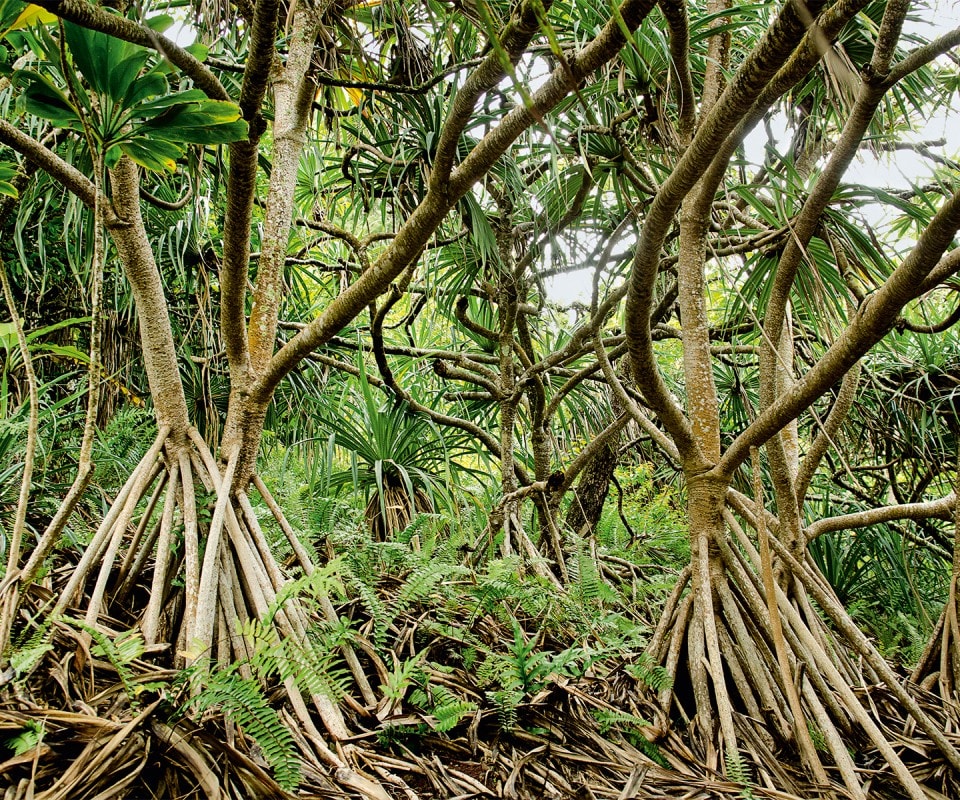
The exuberant Pandanus forest at Pitcairn.
I was trapped on an island, surrounded by thousands of miles of unforgiving sea. I had no ship, and no ships ever came by. I was isolated from the world, from everything I ever loved and longed for, in a prison without bars, on top of a dark rock rimmed by precipitous cliffs. The waves beat the island incessantly, eroding it little by little, and filling the air with an atrocious sound. I could not escape, and lost all hope to ever come back home. My heart was like a drum, panic overtook my mind, and then... I woke up, sopping wet sitting in bed, surrounded by silence, in the middle of a serene night. The moon had painted the sea with a delicate silver stroke, and a light wind caressed the palm trees outside of my window. I was on an island, but that was no prison. I was there on my own will.
My nightmare transported me to 1790, when Fletcher Christian and a handful of British mutineers arrived to Pitcairn Island in the South Pacific, fleeing from His Majesty’s justice, after having taken possession of the infamous HMS Bounty. They and a bunch of Tahitian men and women landed on Pitcairn, then uninhabited, and settled there. Quickly they burnt their ship, which sunk in the shallow reefs, leaving no visible trace. That day they signed their life sentence, hoping to not be found by any passing ship. The odds were low anyway, for the European discoverer of the island made a mistake and mapped it 200 miles off its actual position. But we are told that Christian spent a long time thinking about what they did, looking at the sea from a cave on the cliffs. Maybe I caught a glimpse of his memory during my first night on the island.
The human history of the most famous mutineers of history is the most pervasive memory of Pitcairn. But I was there for something bigger, something with a longer history. I wanted to tell a different story of this part of the world. My mission was to explore the underwater world of Pitcairn and three uninhabited islands nearby, a world that almost no one has seen.
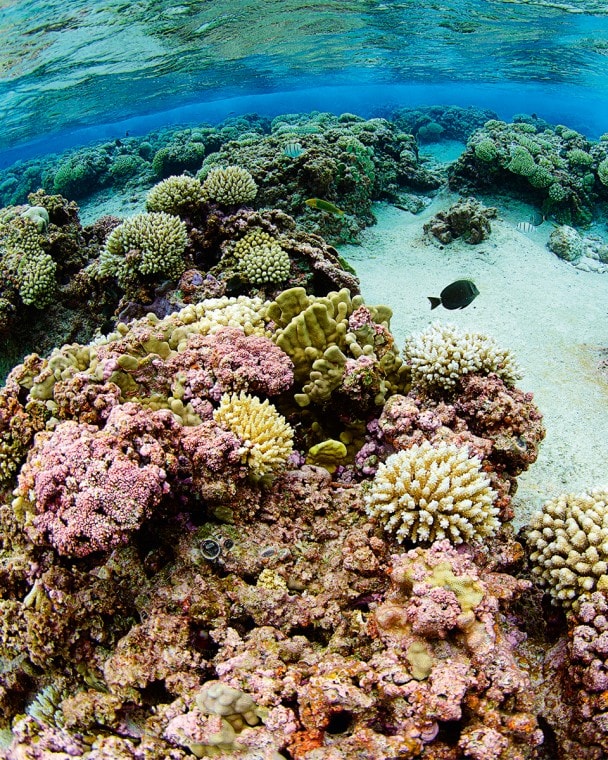
Healthy shallow reefs at Henderson.
In March 2012 I led a National Geographic expedition to the Pitcairn Islands, the only Overseas Territory of the United Kingdom in the Pacific. We collaborated with the Pew Environment Group, an American conservation organization, to assess the health of the marine ecosystems around the islands.
The four islands–Pitcairn, Ducie, Henderson, and Oeno– are one of the most remote archipelagos on the planet. Pitcairn is inhabited by just over fifty people, most of them descendants of the mutineers of the Bounty. The other three islands are uninhabited. Even if you desire to travel to these islands, you will have a hard time. There are no airports, and only one ship travels to the island on a regular schedule–four times a year. Traveling to Pitcairn is traveling back to a time where things take longer, where everything comes into perspective. Out there one realizes what is truly important.
From Tahiti we took a weekly flight to Mangareva, an atoll in the Gambier Islands, the southeastern most archipelago in French Polynesia. The Claymore II, a ship based in New Zealand, was waiting for us there. It then took a night, a day, and another night to reach Pitcairn. During the crossing our ship rolled ceaselessly, climbing up and down swells large as a two-story house. These were long swells, coming all the way from Antarctica, where giant storms unleash the power of the ocean. These swells can still be felt as far North as Hawaii, where they make the delight of surfers. In our case, they made us feel miserable. Our stomachs and heads did not want any part of it, and we chose to hunker down and hibernate.
The morning of the second day we saw Pitcairn arise from the dawn. The sky was the color of lead, and the island was dark and imposing, like an impenetrable fortress. As we got closer, the black became greens and browns and reds. Large chunks of the island had fallen into the sea. The local Pitcairners would later tell us that a month earlier they suffered the heaviest rains in many decades. In just one day they received as much rainwater as they did in the entire previous year. The islands could not take it, and all that land and its precious soil cascaded into the sea. Because of that, Pitcairn was ringed by a halo of brown water. Visibility was less than one meter, and scientific work and filming seemed impossible under such circumstances. In addition, waves kept pounding the island’s shores, and the shallow waters became dangerous for diving. My mind kept asking “What are we going to do now?
“...WE HAVE COME ALL THIS WAY TO FIND OUT THAT WE CANNOT DO OUR WORK.” FOR A MOMENT I FELT DEFEATED BY NATURE.
We have come all this way to find out that we cannot do our work.” For a moment I felt defeated by nature.
Trying to make the best of the situation, we decided to travel to Ducie Atoll, the most remote island in the archipelago, then Henderson Island, and then return to Pitcairn, hoping that by then, two weeks later, the rain and bad weather would have stopped, and diving would be possible. But with a day to kill, we decided to go beyond the murky water. Freshwater and seawater don’t mix easily, for freshwater is less dense. That means that the freshwater with all the sediment stayed on top, and we hoped to find clearer water farther offshore and deeper. We jumped on our zodiacs and rode about a kilometer offshore. The line between the brown water from the island and the clear ocean water beyond was clean and precise. There was no soft transition from brown to blue. Here it was brown, and one centimeter away it was blue.
We moved within the blue and jumped in the water. And we had our first surprise.
Floating on the surface we could clearly see the bottom, at 30 meters depth. The bottom was covered with a healthy coral reef. We descended into the clear blue as though we were falling from the sky. The extreme visibility of the water offshore was unbelievable compared to what we just saw near shore. Already on the bottom, we found that living coral covers more than a quarter of the seafl oor at 30 meters depth. We kept diving deeper, and the coral reef seemed to extend to at least 45 meters depth. Fish were abundant, and curious black trevally circled us at high speed. School of nanwe–the Pitcairner name for the chub–were everywhere, biting on turf algae and then swimming together to the next target. This was an unusually deep thriving coral reef, and the most likely explanation was the extreme clarity of the water.
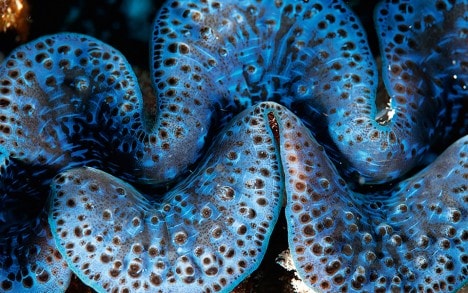
Giant clams are abundant at the Oeno lagoon.
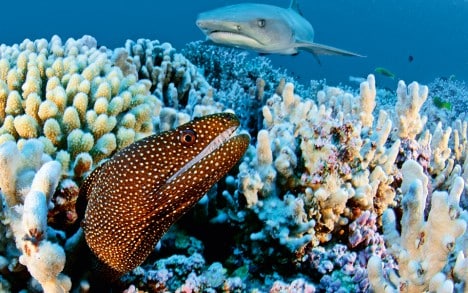
A whitemouth moray eel.
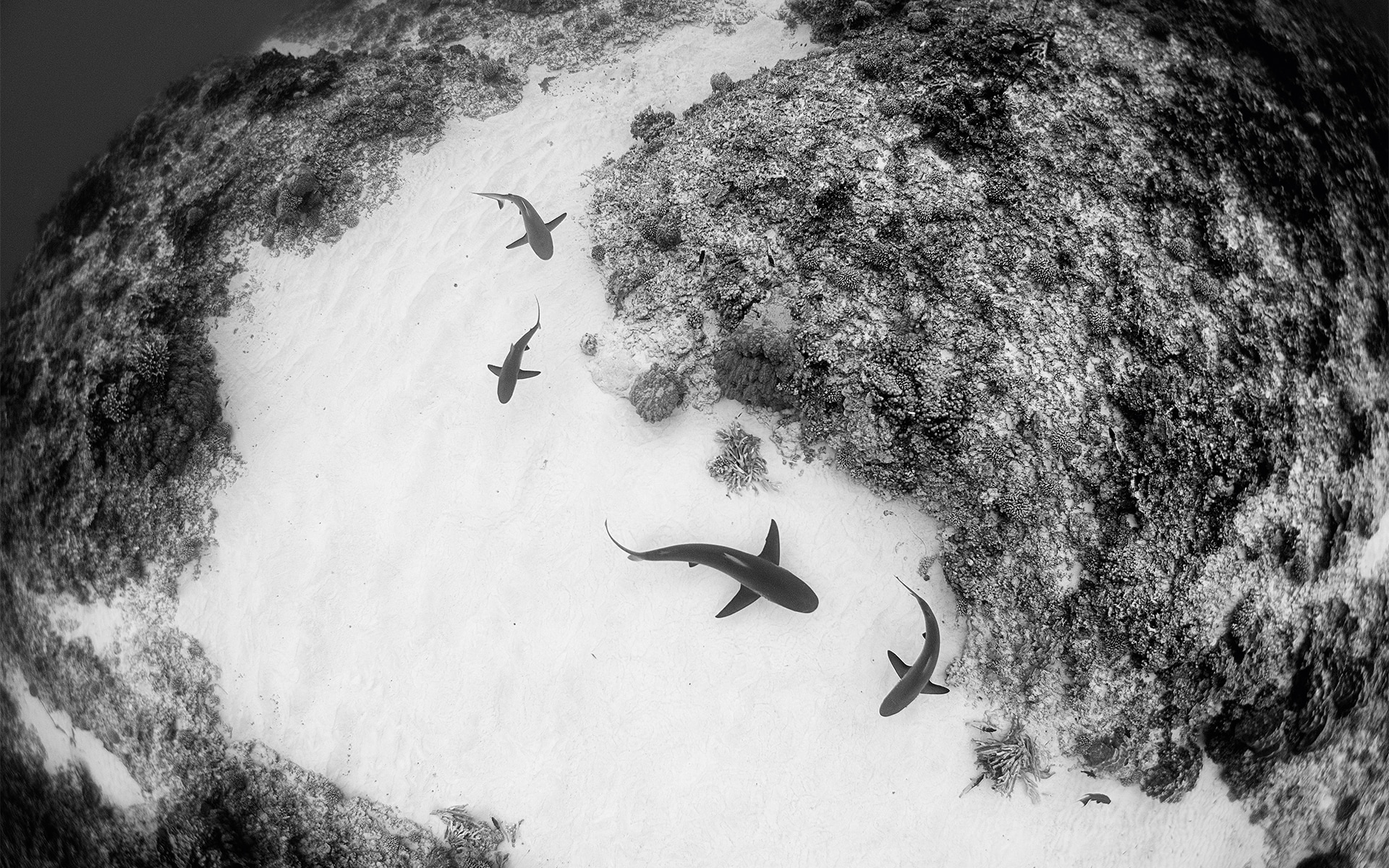
CURIOUS BY NATURE, SHARKS ARE AMONG THE FIRST PREDATORS THAT COME OUT OF THE BLUE TO CHECK US OUT EVERY TIME WE DIVE IN A PRISTINE REEF.
The sea just taught us something, once again. Those who see obstacles as an opportunity to see beyond them will succeed. By looking beyond the murky water we discovered a new reef, which we would have never looked for had we been able to dive nearer to shore.
It took us another day and a half to reach Ducie. The weather improved, and for a few days we had sunny blue skies, which contrasted with a dark blue sea. Ducie is the top of an ancient volcano that emerged from the seafl oor eight million years ago, at the time when the human lineage and chimpanzees separated from a common ancestor. Yet modern humans would not reach Ducie until 1606. Even with a ship and on a calm day, it is not easy to see Ducie. From a few miles away, Ducie is only a slim thickening of the horizon. Its highest elevation is less than five meters. No wonder it took so long to find it.
The water at Ducie reached another level of hyperbole. I had never seen such pure blue, clear water. We could still see each other underwater at a distance of 75 meters! Diving here was like nowhere else. Sometimes I thought what would happen to our minds if humans could, all of a sudden, fly without the needs of airplanes. Would we be able to overcome the sense of vertigo? Would our land-based bodies try to cling to hard surfaces? At Ducie I abandoned those thoughts, for I realized that I was truly flying. Only the regulator in my mouth reminded me that I was surrounded by water.And so we flew, descending from our zodiacs, which from below looked like spaceships hovering motionless on the sky. Diving at Ducie we entered paradise. As far as we could see there was a landscape with smooth rolling hills, a pristine coral reef, with pale blue corals looking like giant roses covering all of the bottom. Man could never dream anything like that.
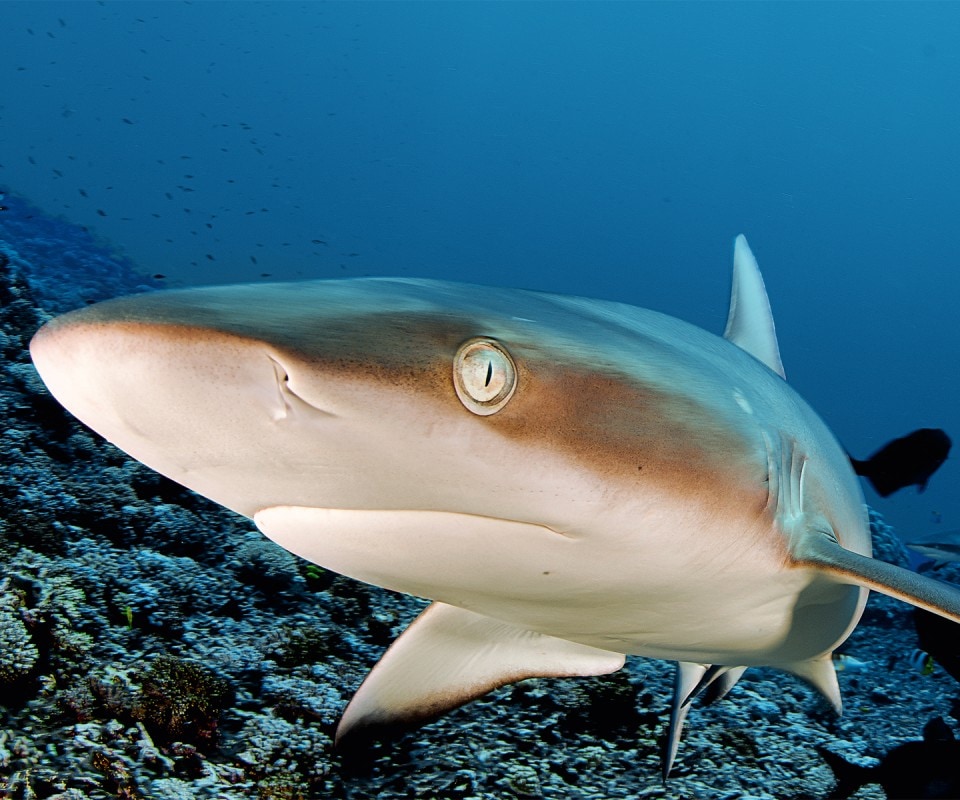
Top predators like the grey reef and whitetip sharks dominate the underwater ecosystem at Ducie and Henderson.
This was an evolutionary dream, the product of millions of years of biological trial and error. This purity was also the consequence of isolation. Far from man, nature is more spectacular.
We were diving with closed-circuit rebreathers, a type of diving gear that recycles the oxygen we breath out, allowing us to stay up to four hours on the bottom without having to resurface. And most importantly, we did not make any bubbles, which allowed us to get closer to marine life. Because Ducie is so remote and unfrequented by humans, many of the fish, including the sharks, had probably never seen humans before. Curious by nature, sharks are among the first predators that come out of the blue to check us out every time we dive in a pristine reef.
When we recovered from the hallucination of the pale blue reef we realized we were surrounded by thousands of nanwe. The nanwe eat algae, and they are supposed to swim near the bottom. But the nanwe at Ducie may not have known, and were darting to the surface in unison and then swimming back to the bottom, like riding a rollercoaster. Among the nanwe we saw our first sharks, grey reef sharks.
As they swam towards us, holes opened on the nanwe clouds, not frantically under the presence of the ultimate predator, but quietly, as though they knew the sharks were more interested in checking us out than in eating them.
Previous visits to Ducie by scientists reported “aggressive sharks”, but we did not see any of that. It would be easy for me to make up hair-raising stories of shark encounters that nobody would be able to contest. But the truth was that the sharks at Ducie were among the gentlest I have ever encountered. They were very curious, and they came on almost every dive to check us out, on occasions so closely that they bumped the domes of our cameras, but we never felt threatened by them. Sharks are the ultimate predators, and they know that the secret to a long life is not to be reckless. While young sharks act like teenagers, cocky and goofy, large sharks are cautious and they approach divers very slowly. They circle you forever, drawing an infinite spiral from the outside in, which never seems to reach the center. And they get scared by brisk movements, so the secret to experience the beauty of sharks is to keep calm.
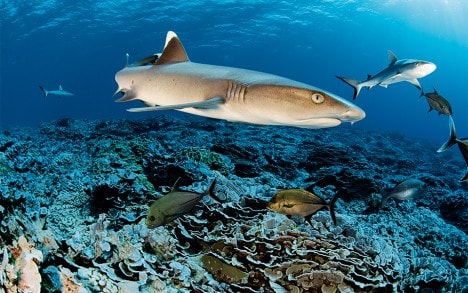

We spent five unforgettable days at Ducie, diving, measuring, and filming. Our studies revealed that, on average, more than half of the reef was healthy corals. In some places, like our dream pale blue reef, corals covered all of the bottom. This is extraordinary in our current world. In the Caribbean, for instance, it is difficult to find a reef where more than 5 percent of the bottom has coral. Fish were abundant at Ducie, and predators dominated. If we weighted all of the fish on the reef, top predators–mostly sharks–would account for two thirds of that weight, what scientists call biomass. Imagine going to the Serengeti in Africa and seeing two lions for every wildebeest. This would be impossible on land, but this is what a pristine coral reef looks like. It’s an inverted biomass pyramid, the best indication of a pristine ecosystem.
After Ducie we sailed to Henderson, where we again suffered large swells from the South and winds from the North. The captain of the Claymore II spent all of five days trying to anchor on a sheltered spot–quite a challenge. I felt like a weathervane, pinned by a thin thread to the only sheltered cove of the island. Our days went by taking excursions on the swells, diving and returning to shelter.
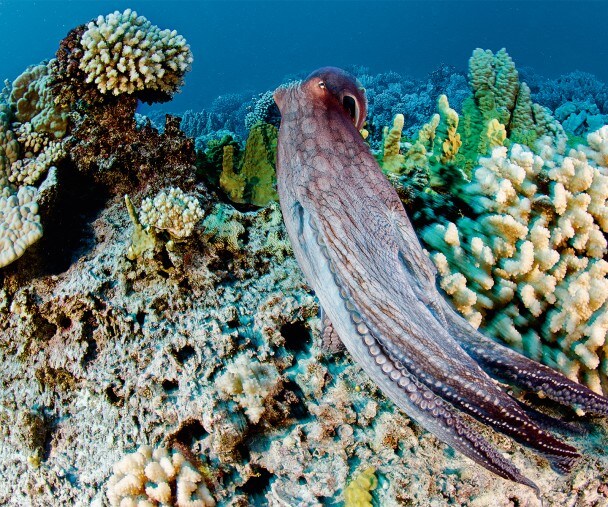
TODAY, HENDERSON LOOKS LIKE A TABLE FROM AFAR. IT HAS VERTICAL CLIFFS – 33 METERS TALL.
At the end of the day we were all exhausted, yet very happy. Henderson underwater proved to be another pristine environment, virtually untouched by humans.
Henderson is a raised atoll, which is a rarity. Eight hundred thousand years ago, Henderson was an atoll, with a coral ring encircling a shallow lagoon–like Ducie. But then another volcano raised from the seafloor, forming a high island that today we know as Pitcairn. That volcano lifted the continental crust, and raised Henderson atoll 33 meters above sea level. Today, Henderson looks like a table from afar. It has vertical cliffs– 33 meters tall–all around, and a shallow depression inland– the ancient lagoon–which is now covered by impenetrable vegetation. Henderson is the last of its kind, the only raised atoll that harbours a pristine forest, including four species of birds that live nowhere else on the planet.
Sharks at Henderson were more curious than those at Ducie. They seemed to love to bump onto our camera domes, and scratched mine beyond repair. Yet we stayed calm and surrendered to the sense of awe and wonder that comes with observing an intact marine ecosystem. My heart was beating slowly and rhythmically, and I had goose bumps underneath my wetsuit. Other than love, this is what makes me happiest and more filled with life. In truth, it is another type of love.
We returned to Pitcairn after five exhilarating days at Henderson. The water cleared up a little, although it was still raining and near shore the visibility was not great. We dived and surveyed the reefs, and filmed. We saw healthy reefs and abundant fishes, but few sharks. We departed with the locals, who showed to us the secrets of their island, and also shared their worries. With an aging population, Pitcairn will need an input of fresh blood to survive. The Pitcairners are reliant on help from the British government to survive. They have fruit trees and some agriculture, they sell a small production of honey, and wood carving and stamps to the odd cruise ship that stops for a few hours near the island. But that is not sufficient to keep their economy going. We kept thinking about their future. Maybe their future depended on something they rarely see.
With those thoughts in mind we sailed to our last destination, Oeno Atoll. The weather got worse, and there was no safe anchorage, for Oeno was only a mile in diameter, barely a refuge in a huge ocean. Swell and wind combines to turn the atoll into a maelstrom, the infamous ocean whirlpool capable of crushing and sucking ships into the abyss. With exhausted bodies after three weeks of diving and sailing, we were paying more attention than usual, being extra careful.
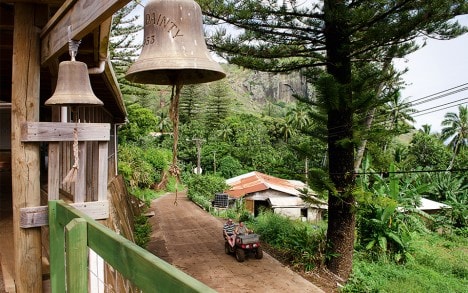
View from the Public Square.
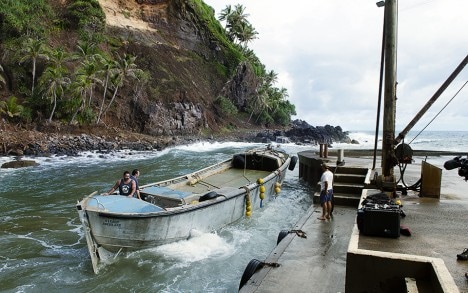
Launching the long boat to go fishing.
IF OENO IS ALREADY THREATENED, WHAT WILL HAPPEN NEXT? WILL THE PRISTINE HENDERSON AND DUCIE BE NEXT?
During a break in the storm we made it into the lagoon through a very shallow pass. An hour after landing on Oeno’s only island, it was pouring once again. Our wet bodies got very cold in the wind, so we explored the lagoon by snorkeling. Over a sandy bottom we found patch reefs covered by a crust of pink encrusting algae, and giant clams so abundant that on some reefs reached densities of up to ten per square meter. On the way out, waves were breaking on the pass. Our skiff hit the reef. The “clunk” felt like a gunshot. My heart raced, and I suddenly felt very warm. Waves were breaking into the boat. Our captain turned around and tried again, and we hit the reef, metal over rock. I hate those moments where I do not know whether we will be able to escape or be trapped. Our captain tried a third time, and he masterfully took us out of the lagoon and into the open ocean, although we banged once again. Back on the Claymore II, we lifted the skiff and saw that our propeller was badly damaged. A small price to pay for our safety.
Dives at Oeno were troubling, and not only because it felt like diving in a washing machine. We were dismayed by the absence of sharks. How in hell we could not find any sharks on a remote, uninhabited atoll? We have explored many coral reefs worldwide, from degraded to pristine, and the only explanation is fishing. Without fishing, reefs have abundant sharks. Their absence is primarily due to overfishing. Oeno is the closest island to French Polynesia, and the Pitcairners report accounts of Polynesian and other fishing fleets targeting sharks at Oeno. If Oeno is already threatened, what will happen next? Will the pristine Henderson and Ducie be next?
There is only one solution: to protect these last South Pacific paradises from the human footprint. Currently fishing fleets are targeting 95 percent of the ocean, and less than 5 percent can be considered pristine. We should not destroy that 5 percent left just because we already degraded the other 95 percent. These pristine places are the only examples we have of a healthy ocean, the only instruction manual of the sea, where we can learn what we have lost, but also understand what the future could be like.
Epilogue: At the moment of writing this article, the Pew Environment Group and the National Geographic Society were discussing with the Pitcairn Island Council and the UK Government the possibility of creating a large marine reserve protecting the 200-mile exclusive economic zone of the Pitcairn Islands. This expedition was the first of the Pristine Seas partnership between Blancpain and National Geographic.
![]()

|
PUBLISHER PROJECT MANAGEMENT EDITORS IN CHIEF CONTRIBUTORS TO THIS ISSUE TRANSLATION |
CONCEPT, GRAPHIC DESIGN, REALISATION ART DIRECTION PHOTOLITHOGRAPHY PHOTOGRAPHERS Release date: November 2012 |



